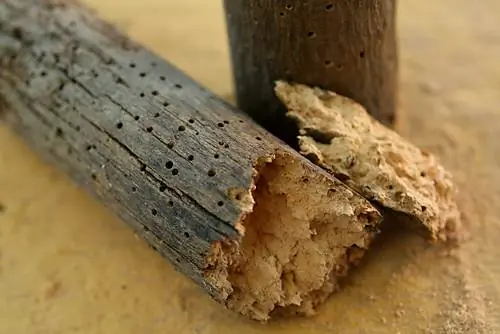- Author admin [email protected].
- Public 2023-12-26 14:17.
- Last modified 2025-06-01 06:02.
Woodworm control has many facets. Measures in the immediate living environment require caution in order to exclude risks for people, pets and the environment. This guide has set itself the task of providing you with comprehensive information about tried and tested methods in the fight against domestic goats and the like. This is how you can successfully identify and combat woodworms inside and outside your house.
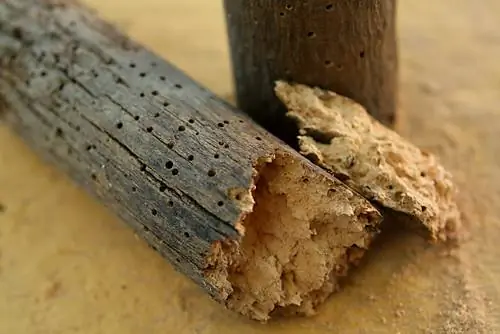
Which places are at risk?
Woodworms primarily target built-up, processed wood in order to lay their eggs. It doesn't matter to the pests how old the piece of wood infested is. The new sauna is not spared, nor is a valuable antique. Against this background, it is not very reassuring that Hausbock and his colleagues generally disdain fresh tree wood in gardens, parks and forests. There are a wide range of veritable places in and around the house for the voracious rabble. The following table lists typical places where you can expect woodworm infestation:
| inside | outside |
|---|---|
| Furniture | Roof truss/roof beams |
| Antiques | Framework |
| Parquet/floorboards | Barn, garden house |
| Wall paneling | Firewood/Firewood |
| Room beams | Front door |
| Living room door | Window frames |
| Stairs | |
| Window | |
| Picture frames | |
| Sauna |
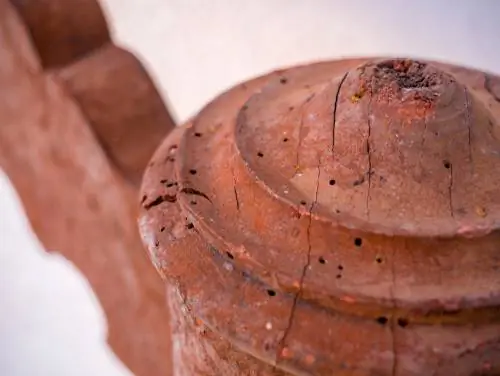
Woodworms attack old and new furniture - unless they are protected
The woodworm doesn't care if you use a piece of furniture every day. As long as the table, chair, cupboard or dresser is made of wood, cheeky female beetles can use any furniture as a breeding ground for insatiable larvae. Antique wooden furnishings are just as immune to wood pests as recently acquired furniture straight from the carpenter's workshop.
Detect active infestation
Before you invest a lot of time, effort and money in combating it, you should make sure that there is an active woodworm infestation. Tiny holes in the wood are just an indication that maggots have been in there at some point. How to determine an acute presence of wood pests:
- Pile of sawdust: lay out dark paper and check for fresh sawdust
- Eating noises: pay attention to audible gnawing noises at night
- Beetles: keep an eye out for live or dead beetles
- Gown through foil: Cover wooden holes with foil in spring and inspect for gnawed exit holes until autumn
- Expert reports: commission a certified expert before starting cost-intensive control methods
If there is no doubt about an active infestation based on the evidence, please proceed carefully. It is rarely necessary to act urgently to combat woodworms. Experience has shown that the woodworm advances its work of destruction at a leisurely but unstoppable pace. For this reason, there is no reason for blind activism, such as using chemical weapons or digging deep into your wallet. In the early stages or in the case of local infestation, there are tried and tested options to combat the pests yourself using natural means.
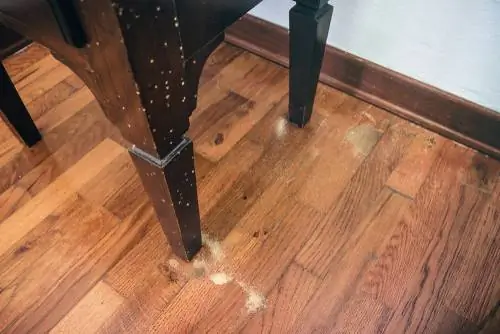
Active woodworms can be identified by the fine sawdust around the affected piece of furniture
Fighting woodworms without poison - an overview of means and methods
The invasive destructive power in the family's immediate living environment makes combating house longhorn beetles, rodent beetles and companions a difficult undertaking. Here the obvious desire for poison-free methods meets a hardened pest species with a clever survival strategy. The following table provides an overview of biological agents and methods that effectively combat wood pests:
| Home remedies | Heat over 55° | Cold below - 12° | mechanical methods | ||
|---|---|---|---|---|---|
| Isopropanol | Oven | Freezer | knock | ||
| Vinegar/vinegar essence | Sauna | Cooling chamber | Acorns | ||
| Salmiac spirit | Microwave | outside (in winter) | Compressed air | ||
| Hot air/hairdryer | Vacuum | ||||
| Drying chamber (carpentry workshop) | |||||
| Foil hood (outside) |
Home remedies versus woodworm - tips & tricks
Local infestation favors woodworm control using natural means. The focus is on proven home remedies, which are mentioned by name in the table above. Below we have put together promising tips for successful application:
- Isopropanol: apply with a paint brush, pack airtight in foil, leave to work for 3 to 5 days
- Vinegar: Fill vinegar essence into syringe and spray into each woodworm hole
- Salmiac spirit: Put on respiratory protection, place wood with open ammonia spirit under a foil cover in the sun for several hours

The use of home remedies should not be taken lightly. Please pay attention to important safety precautions. There is an increased risk of fire when using high-percentage isopropanol. Vinegar essence can damage wooden surfaces. Vapors from ammonia are not only harmful to he alth, but often change the color of the treated wood. Alcohol may act as a solvent. Test in advance in a hidden place to ensure that the wooden surface does not have any negative reactions to the biological agent.
Tip
A double-edged sword in combating wood pests are biological agents with an intense smell. Tea tree oil, linseed oil, gasoline, diesel or petroleum all achieve good results in scaring away or destroying the woodworm forever. The joy of victory is short-lived because you will have to deal with a persistent stench for years.
Thermal combat - instructions for laypeople

Woodworms can be controlled successfully with cold or heat and are completely poison-free
The woodworm is afraid of heat and cold. In fact, the insatiable larvae have no resistance to sweltering heat or bitter frost. Unless there is a large-scale infestation, thermal control of wood pests is very popular because it works without poison and the appropriate equipment is usually available. This is how thermal woodworm destruction works:
- Oven: Heat the wood slowly at 60 degrees and let it cool overnight
- Sauna: gradually heat large wooden parts to 60 degrees and cool slowly
- Microwave: Microwave small parts several times for 90 seconds at 600 watts
- Drying chamber: Have mobile furniture heated up in the drying chamber at a carpenter's or sawmill
- Freezer: Wrap the wood in foil and put it in the freezer for 2-3 days
- outside: expose worm-eaten wood to the cold under a foil cover in winter
The microwave method also promises good success with large-scale woodworm infestations. Of course, different calibers are required for use on large pieces of furniture, thick beams or the entire roof structure than the microwave in your kitchen. Using special emitters shaped like a megaphone, the wood is bombarded with microwaves in sections. Woodworms and other wood pests cannot withstand this treatment for long. Associated risks, such as overheating, the risk of fire or cracks, require many years of experience, which certified exterminators and a reputable specialist company have to offer.
Non-toxic hot air process
Hot air attacks woodworms if the air released is more than 55 degrees Celsius. The hot air process has emerged as one of the best methods for combating woodworm safely and without toxins. Affected surfaces and areas are sealed with tarpaulins, apart from a controlled exhaust ventilation opening. External hot air blowers heat the wood for a period of 8 to 14 hours and destroy all harmful insects inside.
Locally, you may be able to achieve the effect with a hairdryer. The cost-benefit effect is, of course, critically assessed. The power-consuming device should be activated for at least 45 minutes, which will increase the next electricity bill. Furthermore, the air flow is directed at a very narrow radius, so that complete destruction of all maggots is purely a matter of luck.
The woodworm only lives as long as the maggot in bacon until the wood is heated, frozen or soaked in alcohol.
Get rid of woodworm mechanically
The effectiveness of home remedies and thermal methods is optimized with complementary, mechanical strategies. The motto applies: with carrot and stick. By constantly making a racket, you make the beasts' lives hell. At the same time, offer the larvae a tempting treat outside of the wood as a place to retreat. This is how the plan works:
- Lay out acorns around the affected wood
- From now on, knock hard on the wood at every possible opportunity
- Exchange acorns with feeding holes for fresh fruit every 2 to 3 days
- Dispose of acorns infected with woodworm in the compost
- Continue until there are no more drilled acorns to be found
Woodworm larvae are clever and don't always fall for the knocking acorn trick. If the results fall far short of expectations, compressed air technology is another mechanical approach. To do this, blow out each feeding passage with compressed air from the round entrance. Since you are unable to see inside the wood, you can never be sure with the compressed air method that you have caught all the vandals.
Last resort pesticide
If all efforts at biological control come to nothing, the chemical club is waiting at the end of the tunnel. Specialist retailers offer numerous pesticides that kill woodworm larvae. The downside of the coin are toxic ingredients such as permethrin. This is a neurotoxin that is dangerous for people and pets. Important safety precautions must be taken in advance, which each manufacturer explains in detail in the package insert. The following products are rated as effective by users suffering from woodworm:
- Envira woodworm spray at a price of 11.80 euros for 500 ml
- Kluthe woodworm death at a price of 17.99 euros for 2.5 l plus 5 disposable syringes at a price of 8.95 euros
- Xyladecor against woodworms with spray head at a price of 11.50 euros for 250 ml
- Woodworm stop with injection attachment from Detia Garda at a price of 9.90 euros for 200 ml
The undisputed test winner is the woodworm spray from Envira. The product is non-corrosive, odorless and non-flammable. The knock-down effect on the woodworm is based primarily on the ingredient permethrin. For large-scale use, the manufacturer offers inexpensive refill packs with 2 or 5 liters.
Entrust large-scale control to professionals
If the roof structure or supporting parts of the building are contaminated with woodworms, you should refrain from doing it yourself. Large-scale combat on your own is associated with imponderable risks and is rarely successful. Instead, rely on the experience of experienced and certified experts, because after all, it's your home that's at stake.
Background
Chemical fumigation is criticized
As an alternative to the hot air process, specialist companies offer the option of fumigation of infected roof trusses, apartments and houses with a special poison, usually sulfuryl fluoride or a mixture of sulfur and fluorine. This gas reliably destroys all wood pests and works without a sustained effect, so that treated rooms can usually be used again after 24 hours. The comparatively high cost factor is seen as a disadvantage due to the complex preparations. Furthermore, special technology is used that requires in-depth know-how. Last but not least, the prospect of living in a toxic house leaves many people feeling uneasy.
The Football World Cup has begun. ⚽️But what looks like decoration for public viewing is just a protective cover to combat woodworms in the open-air museum wm2018 ⚽️ soccer ?? flag germany publicviewing worm foodball restoration germany restoration woodworm control freilichtmuseumdetmold lwlfreilichtmuseum
A post shared by elke kirchhof (@kirchhofelke) on Jun 14, 2018 at 9:57pm PDT
Woodworm is a beetle larva
The term woodworm acts as a synonym for a whole flock of flying beetles and their larvae. If tiny holes in the wood of the roof structure, furniture or beams cause headaches, you are not dealing with a worm infestation. Rather, you are confronted with the destructive breeding of the following species of beetles, which eat their way through the wood in the form of cylindrical maggots:
- Longhorn beetle, primarily house longhorn beetle (Hylotrupes bajulus): 8-26 mm long, winged, brown to black and gray haired
- Common rodent beetle (Anobium punctatum): 2-5 mm long, winged, reddish-brown, very hairy, hood-like pronotum
- Colorful throbbing beetle (Xestobium rufovillosum): 5-7 mm long, winged, dark brown with yellow hair spots
- Trusthead (Hadrobregmus pertinax): 4.5-6 mm long, winged, black-brown, cylindrical, sparsely hairy
- Brown sapwood beetle (Lyctus brunneus): 2.5-7 mm long, winged, reddish-brown, smooth, dotted elytra
Maggots of these beetles are difficult for laypeople to distinguish according to species, because the color of the worm-shaped bodies is uniformly white to cream. Over the course of several larval stages, house longhorn beetle larvae reach lengths of up to 30 mm, whereas rodent beetle larvae rarely become longer than 5 mm.
Lifestyle
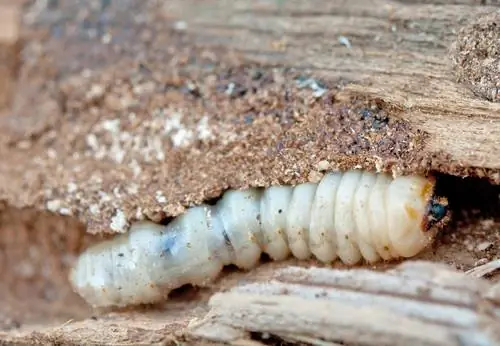
The larvae of woodworms silently and secretly eat their way through the wood
A female beetle - depending on the species - lays up to 200 eggs a year in the wood and then leaves the brood to its own devices. Within a short time, the eggs transform into insatiable larvae, which crawl through the beams, parquet, furniture or other processed items Drill wood. Up to eight years pass before the larvae of the common rodent beetle pupate. The larvae of the house beetle cause mischief for up to 15 years. Only then does metamorphosis into an adult beetle take place. On the way there, an extensive system of feeding passages is created, which significantly impairs the stability of the wood and, in the worst case, causes entire roof trusses to collapse. The lifespan of a finished beetle extends over a few weeks during which no food is consumed.
This short excursion into the biological background of woodworm species makes no claim to scientific quality or completeness. Various Wikipedia articles provide comprehensive information about the woodworm.
Excursus
Do not confuse house buck with wooden buck
The naming of two completely different insects poses a high risk of confusion, which can have fatal consequences. A species of longhorn beetle (Hylotrupes bajulus) spreads fear and terror in Europe under the name house longhorn beetle, which is also known as the large woodworm or log beetle. This guide is dedicated to effectively combating these wood pests. The name wood tick (Ixodes ricinus), on the other hand, refers to one of the most dangerous tick species that can cause significant he alth damage to people and pets. Confusion of the two terms should be ruled out beforehand when choosing control agents because most anti-house beetle agents are ineffective against wood beetle and vice versa.
Frequently asked questions
What costs should be expected if an exterminator is hired to combat woodworm?
Estimating the costs of using a specialist company in advance is difficult or impossible. Numerous factors determine the final price, such as the location of the infestation, type of pest, infestation pressure, control method and time required. A reputable company will first inspect the property and then prepare a cost calculation. A rough guideline for the hourly wage is 100 to 150 euros. Killing wood pests in built-up wood using a non-toxic microwave or hot air process costs an average of 600 euros.
Where can I buy woodworm control products?
Biological agents, such as isopropanol or ammonia, are available at hardware stores, for example Obi, Toom or Hornbach. The range also includes insecticides, such as the test winner Envira Holzwurmtod or the proven wood preservative Xyladecor for protective exterior paint.
My old dresser is infested with woodworms. I've heard that cold kills pests. Is it enough to put the old furniture on the balcony when it's frosty?
Fighting woodworm with cold requires that you expose the infected dresser to frost below -12 degrees Celsius for 48 to 72 hours without interruption. In Germany, this premise cannot be met in most regions because temperatures exceed the threshold, at least during the day. If the balcony is in a winter-harsh Alpine region or in the Ore Mountains, it is at least worth a try.
I read on the Internet that the woodworm can be controlled with nitrogen without poison. Can I use the method to combat pests in a living space myself?
Fumigation with nitrogen works on the suffocation principle to kill the woodworm. For this purpose, infected wooden objects or an affected living space must be enclosed gas-tight with foil so that no oxygen can penetrate. Constant temperatures above 20 degrees Celsius and a treatment period of 8 to 10 weeks are crucial for successful control. During this time, no one is allowed to come within 10 meters of the apartment without special protective equipment. The control method is only permitted throughout Europe to certified specialist companies.
Fighting woodworm with hairspray - is that possible?
In one forum or another you can read that hairspray is a good home remedy against woodworms. Theoretically, the spray could clog the maggots' sensitive respiratory organs, causing them to suffocate. What is underestimated in this context is that these are clever pests that eat deep into the wood - unreachable for non-toxic hairspray. Effective woodworm spray contains toxic components and is not just sprayed on the surface. Commercially available products have an injection attachment so that the insecticide can be delivered deep into the feeding ducts.
Where can I find the contact details of certified woodworm control professionals?
The German Wood and Building Protection Association e. V. operates a meaningful database that can help you find a qualified company to combat wood pests in your area. Based on your zip code, an intuitive search mask guides you step by step to the contact details. As a rule, there are several DHBV specialist companies to choose from.
Tip
In a vacuum, the woodworm runs out of air after four to twelve weeks at the latest. In order to free valuable antiques or irreplaceable family heirlooms from wood pests without using poison, specialist companies offer temporary or permanent storage in an almost vacuum-free space. For handy, small furniture, the method also works on your own, as long as the affected part fits into a vacuum bag measuring 180x90x50 cm and a vacuum sealing device is available.

